The Cup Bearer Who Became King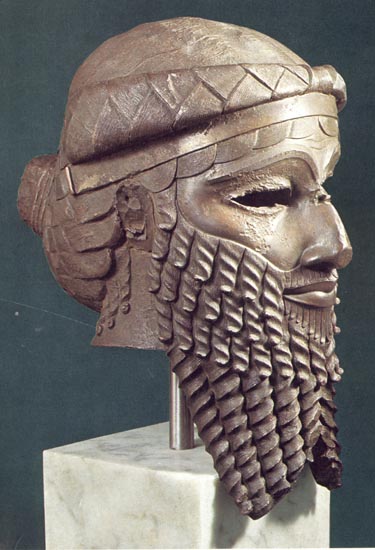 Bronze head of Sharru-Kin (Sargon) from Nineveh After Gilgamesh, 7 more kings are recorded as ruling over Sumer and Akkad from Uruk, each one reigning a pitiful 6 to 30 years a piece, before Mesannepadda ("An's Chosen Hero") conquered the city-state and made Ur the capital. The king lists say that the first dynasty of Uruk lasted 2,310 years but archaeologists believe that it was closer to 260. After this "Heroic Age"5, the reigns of individual kings never tops 1,000 again. Cylinder seals excavated from a royal cemetery in Ur bear the inscriptions "Meskalamdug, King" and "Akalamdug, King of Ur" have been found, both beneath recovered seal inscriptions of Mesannapadda, seeming to indicate that they ruled before him. The lavish cemetery dates from before Mesannapadda and holds around 17 tombs. Fifteen of them were found with anywhere from between 3 and 74 attendants buried with them in each tomb, most of them women. Lugal-Kitun of Uruk and Mesalim of Kish were both defeated by Mesannepadda, who set up the first dynasty of Ur. The king lists say that this dynasty lasted 170 years while the current estimation puts it at around 110 years (2560-2450). Ur fell to foreign invaders, the Elamites from the city of Awan, west of Susa and the Karkheh river. The king lists say Awan held kingship for 356 years, but evidence seems to indicate that they began encroaching in Sumerian land about a decade before they overthrew Ur in 2450 BC. The Elamites held some dominion over Sumer for about 40 years (2460-2420) until they were driven out by En-Shakushanna of Uruk along with Elamites from Hamazi. The king lists do not mention this. No records of the 8 kings of the Second Dynasty of Kish could be found, but a lost dynasty consisting of 5 different kings were found who ruled concurrent with the rulers of Ur I and Awan. After 3,195 years Kish II was supposed to have been defeated by the Hadanish of Hamazi, an Elamite who ruled for 360 years (more like 20). According to modern estimation Hamazi was a contemporary of the First Dynasty of Ur (2450-2430) rather than ruling 3,722 years afterwards. The king lists say that Hamazi was defeated by Enshakushanna of Uruk, who founded the Second Dynasty of Uruk. After 3 kings and 187 years, Uruk was said to have been defeated by Ur once again, although in reality they seem to have ruled side by side for about half as long. After 582 years, Ur II is said to have been defeated by Lugal-Annemundu of Adab, although there seems to have been a brief and unrecorded Elamite dominion before this. Later documents from Lugal-Ammemundu's reign state that he controlled the entire fertile crescent, from the Mediterranean Sea to Elam. He was called "King of the Four Quarters of the Universe" and "He who made all the foreign lands pay steady tribute to him, who brought peace to the peoples of all the lands, who built the temples of all the great gods, who restored Sumer to its glory, who exercised Kingship over the entire world". It is also said that 13 rulers banded together to rebel against him but were all defeated. Each of these rulers had a Semitic (Akkadian) name, even the ones from Elamite cities. It is said that Lugal-Annemundu later campaigned deep into the Zagros mountains, conquering territory to the north all the way to the land of Gutians. If this is true, then he would be the first emperor to unite all of Mesopotamia, but the king lists have nothing more to say about him other than he reigned for 90 years. Whatever the case, his dynasty did not last past his lifetime. Even if Lugal-Annemundu did reign for 90 years, it still would not have been worth the attention the people of western Mesopotamia gave the fertile crescent for the next 160 or so years. Mari, a city on the far west side of the Euphrates, was the next capital on the king lists, whose recorded 6-king reign of 136 years is actually smaller than the modern estimation. The Anbu Dynasty of Mari is recorded as being defeated by Kubau the Tavern/Inn Keeper, who is believed to have lived around 2400 BC. Her sole reign of 99 years is considered to be the Third Dynasty of Kish. Then, after 7 kings of Akshak rule another 99 years, Kubau's son Puzur-Suen came back to wreck his mother's revenge. Some king lists record this as the Fourth Dynasty while others list them as one dynasty. His reign is recorded as being 25 years, in which he then passed the crown to his son Ur-Zababa for 6 years. Although the kings lists say that there were 5 more kings after Puzur-Suen's dynasty before kingship was taken over by Lugal-Zagesi, other records say that Ur-Zababa was a contemporary of Lugal-Zagesi. Most king lists record Lugal-Zagesi's 25-30 year reign as the only king of the Third Dynasty of Uruk (2345-2316), but one of them omits Uruk III entirely. Lugal-Zagesi's ambition was to fulfill the lost accomplishments of Lugal-Annemundu and reunite the lands of Akkad, Sumer, Elam and the Levant (Ugarit; Syria), although his objective would take a different form than he planned. A text found in Lagash called Umma and Lagash tells of a dynasty in Lagash from around 2500 BC. The text states that in the days when the "King of Kish" was Mesalim, there was a border dispute between Umma and Lagash, two cities situated 18 miles apart from each other. The text opens saying that Enlil, father of all the gods, had established the boundary line through Mesalim, the "King of Kish" (though he does not appear in the king lists). However, the ishakku (priest-king) of Umma violated his word, ripped out the boundary line stele, and seized land away from Lagash. So according to Enlil's command, Ningirsu (Ninurta) did battle with Umma, threw his great net upon them, and buried the bodies in a great mound in the plain. But apparently, this happened some time later, when Lagash came into military superiority under the reign of Eannatum. King Eannatum restored the stele, built several sanctuaries to the gods, and allowed the people of Umma to farm part of their territory, but only if they repaid them in grain for the service. Eannatum ruled concurrently with the dynasties of Ur I, Awan, Kish II, Hamazi, and Uruk II. From other sources we know he eventually claimed to have defeated Umma, Uruk, Ur, Akshak, Mari, Susa, Elam, and several districts probably inside the Zagros mountains. He also assumed the title "King of Kish". The second document proceeds to around the time of the author. A king of Umma named Ur-Lamma withheld on this taxation and then drained the ditches at the boundary line and put to torch all of the boundry steles and their annoying proclamations. By then Eannatum's crown had passed to his brother, Enannatum. "As puffed up as the mountains" the army of Umma crossed over Ningirsu's boundry line, but was met by a force led by Enannatum's son: Entemena. The king's son defeated Umma's forces, captured the ishakku as he was running away, and slew him in front of his men. Eannatum's victory was commemorated by a stele depicting vultures tearing up the corpses of the defeated. The 60 men who died were buried in five mounds on the bank of the canal, and was called "Meadow-recognized-as-holy-from-the-great-dagger". A priest of Inanna by the name of Ili from the city's temple of Esh was then chosen to be the vassal ruler of the city.  Stele of the Vultures, commemorating Eannatum of Lagash's defeat of Umma, 2525 B.C. 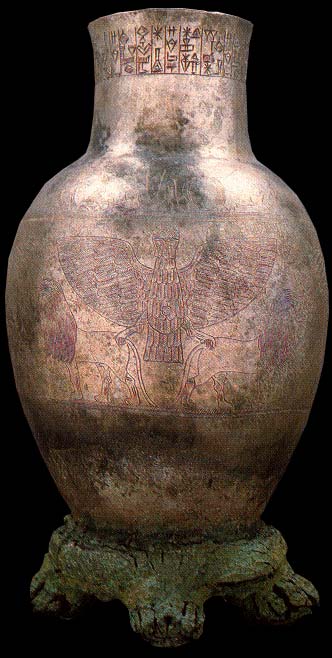 Entemena's Anzu-styled vase, dedicated to Ningirsu (Ninurta) of Lagash, 2505-2375 B.C. Unfortunately, the vassal ruler that Enannatum set up did not prove to be a loyal retainer. The third document tells how Ili drained the boundry canal and stole Lagash's grain. When Eannatum declared hostility on him, the priest of Inanna flooded the fields, had the boundry canal of Ningirsu ruined, destroyed the stela of the vultures, and took control over the land. The resolution to this is enigmatically summed up as "Enlil and Ninhursag did not permit this to happen". Apparently some compromise was made. The boundry line was restored to its old position and Eannatum had the canal restored. This may mean that a compromise had been set up involving the authorities of Nippur and Adab, the latter of which is just north of Umma. The text concludes with a prayer asking Enlil to destroy any trespasser, whether Ummaite or foreigner, and asking Ningirsu to hurl a net over the trespasser so that the people of the city can kill him a second time. If Umma and Lagash fulfilled it's purpose of explaining border line disputes and political upheavals of the Ur-Nanshe dynasty away as religious phenomenon, the heroics of Eannatum and his kindred did not inspire future generations of Lagash citizens to look past government corruption or accept gratuitous taxation by them. A social reform text has been found dating to the time of King Uru-Ka-Gina, who is said to have stopped the political corruption of the former dynasty. It is said that the inspectors of cattle, boats and fisheries often stole what they inspected and that taxes were levied on perfume, divorce, death, and wool that was white. The gods' oxen were said to plow the king's onion patch. Urukagina is recorded as having put a stop to all of this and also to have promulgated the oldest surviving law codes to date, which where uncharacteristically humane compared to later law codes, rarely resorting to the death penalty. But the laws would not benefit the city long because within 10 years the bitter hatred of Umma would come to haunt them again when the priest-king Lugal-Zagesi invaded Lagash with forces from Umma and razed the city, carrying off the temple's statue of Ningirsu. The chroniclers of Lagash cursed him, writing, "The men of Umma, by the despoiling of Lagash, have committed a sin against the god Ningirsu.... As for Lugal-Zagesi, priest-king of Umma, may his goddess Nidaba make him bear his mortal sin upon his head!". Lugal-Zagesi went on to conquer Ur an Uruk under the name of Enlil, making Uruk his capital, cementing an alliance there. He claims to have then unifed all Sumer and to have taken control of the trade routes from the Mediterranean to the Persian Gulf. But he would never reunify the lands of Akkad, Elam and the Levant, and his 24 year rule would mark the end of the Sumerian kingdom. All this because of a cup bearer who came to his castle as a messenger. There is a damaged text with a missing conclusion called The Sargon Legend, made up of three segments, which tells about Sargon's days as a humble servant. In the first segment, Kish is said to have become a ghost-town, and that by the holy command of An and Enlil Ur-Zababa's reign had been altered and the prosperity of his palace removed. Although other sources say Sargon didn't know his father, this text identifies him as La-Ibum. There is more text regarding the circumstances surrounding Sargon's birth but the rest of this segment is missing. The second segment says that while Sargon was making a delivery to Ur-Zababa's palace, he somehow felt what the king was dreaming about but didn't tell anyone. When Ur-Zababa awoke and received Sargon's deliveries, he made him cup bearer and put him in charge of the drink cupboard. It is said that holy Inanna did not cease to stand by him. Five or ten days passed and the king began to grow sick and develop a bladder control problem, even discharging blood and pus. Sargon then 'laid down not to sleep but to dream' and had a premonition of Inanna drowning the king in a sea of blood. Ur-Zababa heard the groans he made in his sleep and asked him what he had been dreaming and Sargon told him. The king grew even more afraid and began biting his lip. He decided that Inanna would change her mind and take Sargon's life instead if he just helped it along, so he ordered his smith Belishtikal to wait for Sargon in the E-sikil, 'the fated house', and then throw both him and his package (which might have been a bronze mirror) into the mould like a statue. The king sent Sargon there with the package, but Inanna stopped Sargon before he entered and told him that he could not enter the E-sikil while unpurified by blood, so Sargon instead made the chief smith come out to him and gave him the mirror at the gate, avoiding assassination. Knowing that he is fated to become king, Sargon becomes 'founded like a mountain' and Ur-Zababa begins to fear his presence, though he never said anything about it. Ur-Zababa then sent Sargon on an errand to carry a clay tablet to his most powerful rival, Lugal-Zagesi, and the text informs us that this was a historic moment:
In those days, although writing words on tablets existed, putting tablets into envelopes did not yet exist. King Ur-Zababa dispatched Sargon, the creature of the gods, to Lugal-Zagesi in Uruk with a message written on clay, which was about murdering Sharru-Kin.
Just as the story gets interesting, the rest is of the text is destroyed. There is something about Lugal-Zagesi's wife's femininity being a shelter in the third segment and something about Lugal-Zagesi not talking to an envoy for a time but when he did, he despaired and sat in the dust, and told the envoy that Sargon would not submit. It has been conjectured that Lugal-Zagesi helped Sargon overthrow Ur-Zababa to force an alliance with Nippur and Kish. One thing that's known for sure is Ur-Zababa was out of the picture before long. One of the prayers written by Lugal-Zagesi during the time of his military dominance reads:
May the lands lie peacefully in the meadows. May all mankind thrive like plants and herbs; may the sheepfolds of An increase; may the people of the Land look upon a fair earth; the good fortune which the gods have decreed for me, may they never alter; and unto eternity may I be the foremost shepherd.
Another inscription found in Nippur reveals what fortunes were in store for the great conquerer:
Sharru-Kin, the king of Agade, the King of the Land, laid waste the city Uruk, destroyed its wall; fought with the men of Uruk, conquered them; fought with Lugal-Zagesi, the king of Uruk, took him prisoner and brought him in a neck stock to [Nippur/Kish].
Lugal-Zagesi was then chained by the neck to the "Gate of the Enlil", after which he was never heard from again. 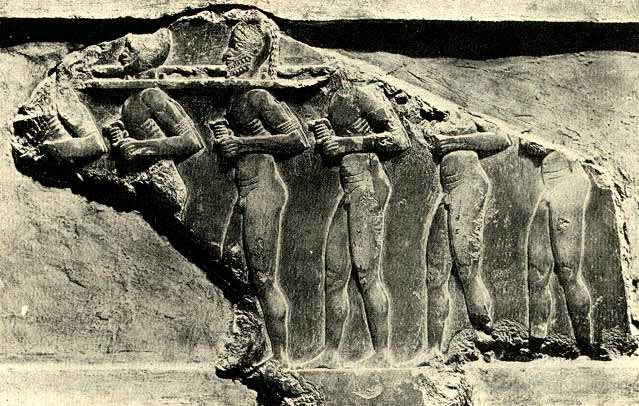 Stele of Sargon's Slaves Sargon's real name is not actually known. The name of a later Assyrian king who bore his name was translated in the book of Yesha-Yahu (Isaiah) as Sargon, but the name is actually Sharru-Kin, meaning "Legitimate-King". The reason for the original Sharru-Kin taking a name like that leads to the presumption that he was the exact opposite. The House of Lugal-Zagesi had 50 ensis (governors) at their command, but they were all defeated when Sharru-Kin launched his surprise attack. After consolidating his power in the northern territories of Akkad, he went down the Tigris conquering Umma, Lagash and Ur and then "stopped at the lower sea [Persian Gulf] to wash their weapons". Although he was already King of Kish, he built a new capital with double fortifications and called it Agade, which gave Akkad its name. He also built a huge temple to Ishtar (Inanna) and another for the warrior god of Kish, Zababa, perhaps in Ur-Zababa's memory. The now lost city of Agade's location is said to have been on the Euphrates and is believed to be very close to later-day Babylon, if not within the city's borders itself. With the rise of Akkadian power, their Semitic tounge replaced Sumerian as the official language and Akkadian governors were appointed in all the major cities. Following Sumerian religious traditions, Sargon appointed himself the anointed priest of Anu and the great governor of Enlil and gave his daughter Enheduanna the position of high priestess of Suen (Nanna) in Ur. He traveled to the east and conquered Elam and Barhashe. It is said he then went northwest and prostrated himself in front of Dagan, who gave him the cities of Mari, Iarmuti, and Ebla, all the way to the Cedar Forest (Lebanon) and the Silver (Taurus) Mountains. He is even quoted as conquering the Sumerian Eden. Sharru-Kin is believed to be the first person to unify the many different cultures of Mesopotamia under one nation, the Akkadian Empire, which was formed sometime between 2334 and 2371 B.C. Later documents say that Sargon ruled over 65 cities and boasted that trading vessels from Meluhha (Northwestern India), Magan (near the Gulf of Oman), and Dilmun (Eden) came to his capital. His former status of cup bearer is said to be some type of treasurer, but another text written in his name has Sargon claiming to be a former gardener. This text, named similarly to the last one, is the Legend of Sargon, which gives a short background of his life in first person:
Sharru-Kin, the mighty king, king of Agade, am I.
The meaning of his mother being a changeling is unknown, but it has been suggested that it means he was the illegitimate child of a temple prostitute.
"Now a man of the house of Levi married a Levite woman and she became pregnant and gave birth to a son. When she saw that he was a fine child, she hid him for three months. But when she could hide him no longer, she got a papyrus basket and coated it with tar and pitch. Then she placed the child in it and put it among the reeds along the bank of the Nile." -Exodus 2:1-3
Like Sargon and Moses, the legendary founder of Rome, Romulus, is also said to have been set down the river in a similar legend. All three of these men were legendary founders of great nations. There is a good possibility that Sharru-Kin is also the Biblical king Nimrod:
"Kush was the forebear of Nimrod, who grew up to be a mighty warrior on the earth. He was a mighty hunter before Yahweh; that is why it is said, 'Like Nimrod, the mighty hunter before Yahweh.' The first centers of his kingdom were Babylon, Erech [Uruk], Akkad, and Calneh(?) in Shinar [Babylonia]. From that land he built Nineveh, Rehoboth, Ir, Calah and Resen, which is between Nineveh and Calah; that is a great city." -Genesis 10:8-12
Sharru-Kin ruled over all these lands and became the legitimacy from which New Kingdom emperors of Babylonia and Assyria based their authority to conquer neighboring countries. It is from the texts of these later empires that everything about Sharru-Kin is known. The later Assyrian king who took his name (721-705 BC) made Ninevah his capital. The only likeliness we have of Sargon the Great was excavated from that city as well. His dominion of Uruk is one of his most famous endeavors and he is the only person who could have been said to have founded Akkad. Nimrod literally means "Let us revolt", and Sharru-Kin's standing as an usurper is certainly pervasive today. Regarding Nimrod's reputation as a mighty hunter, one of the advantages attributed to Sharru-Kin's success in battle was the invention of the composite bow, seen drawn for the first time in depictions of his army. The city of Calah, now called Nimrud, was a village of no importance until the Assyrian king Assurnasirpal II (883-859 BC) made it his capital, but he lived far too late for the Genesis times. 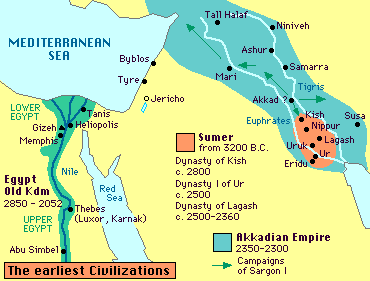 Sharru-Kin's daughter, the high priestess of Ur, was Enheduanna. The En prefix is a title denoting her priesthood. The second half of her name, Hedu-Ana, means "Ornament of Heaven". She is the first author known by name whose works still survive to this day. Although her father changed the official language of the lands to Akkadian, her name and her poetry is Sumerian. There are six poems associated with Enheduanna, which are sometimes referred to in the tradition of calling it by the manuscript's first words: Nin-me-sar-ra ("Lady of Infinite Arts"), In-nin Sag-gur-ra ("Stout-hearted Lady"), In-nin Me-hus-a ("Inanna and Mt. Ebih"), E-u-nir ("House of the Ziggurat"), E-u-gim E-a ("Hymn to Ereshkigal and Nanna for En-ship Assumption"), and a hymn in praise to herself. The title of this, her most self-indulgent work, was broken off.  Limestone Disk from Ur of Enheduanna with a priest and two priestesses The poem Nin-me-sar-ra ("Lady of Infinite Arts"), also known as The Exhaltation of Inanna, consists mostly of glorifications to Inanna as guardian of the me, or sacred arts. An earlier Sumerian myth, Inanna and Enki, tells how Inanna got Enki drunk and was able to convince him to let her sail the 94 sacred arts from his underwater temple to the city of Uruk. These "arts" included offices of priesthood, articles of clothing, attributes, emotions, different forms of speaking, music, stages of intimacy, and prostitution. Beer is in there too. Enki sends out his messenger Isimud to stop Inanna from delivering these secret arts to the people of Uruk. Isimud catches up to her and Inanna becomes outraged that Enki would change his mind after he promised to let her take them. They get into a repeating argument as the minister tries to humbly convince Inanna to return. Although the ending is fragmented, we can tell something must have been worked out as there is mention of a festival. The text seems to insinuate that Uruk learned the arts of civilization from Eridu and that Eridu at first resented this. Besides honoring her role as guardian of these arts, Enheduanna's Exaltation also goes into great detail as to the devastation Inanna will bring to those who refuse to bow down to her. In her venerations to Inanna, she says that the goddess is even greater than her mother (Ningal). The focus then turns to the priestess herself, recounting how she went into her special fortune room in Ur named Gipar:
Into my fate-determining Gipar, I had entered for you.
She writes of a situation she is having with Lugal-Anne, which is a generic name given to local rulers. She asks that Inanna report her fate with Suen (Nanna) and Lugal-Anne to An so that he would resolve the situation. She eventually reveals that Lugal-Anne has incited a rebellion within Ur and after he stood in triumph she was expelled from the temple and forced to "fly like a swallow from the window". She takes this Sumerian revolt to mean that the moon god Suen has abandoned her and no longer cares for her, adding an insinuation that it did not matter what Suen decreed. She prays to Inanna, shedding tears "like sweet beer", asking Inanna not to concern herself with Suen, since by changing the purification rites that An had set out, the moon god had not shown proper respect for An's authority. She asks An to strike down the rebellious territory and for Enlil to curse the land. She prays that Inanna's ship of wailing will be left in the enemy lands and repeats the passages regarding her flight from the temple and the inconsequence of whether Suen decreed the uprising or not. She laments how her rightful crown had stolen off her head but then turns her focus back to Inanna, saying that although she had been born a minor goddess, she had now risen above the Anuna gods. In this, she seems to reconcile Suen's inability to help her as proof of Inanna's ascension over her father and the other gods:
that he has said, "It is yours", My Queen- it has made you greater, you have become the greatest!
She then says that she has prepared the purification rites and asks that Inanna calm down for her, saying that because Inanna's heart was so full, she would give birth for her. She promises that this song, normally sung at midnight, would be repeated in the middle of the day as well:
because of your captive protégé, your anger has grown large, your heart has not calmed down."
This chorus seems to indicate that Inanna's wrathful heart comes from the memory of Dumuzi's death. Enheduanna's poem ends saying that Inanna accepted the prayer and sacrifice, then became draped in enchanted moonlight and was blessed by her mother Ningal. It is believed that the rhetoric of this "Jewish princess" was copied and publicized to serve as propaganda for Shurru-Kin's regime, though the lesson seems to be that Enheduanna's personal goddess grew vastly more powerful due to the author's discredit. The concept of Inanna as a war goddess as well as being the chief matron of love and fertility is prevalent in later Babylonian stories as well. 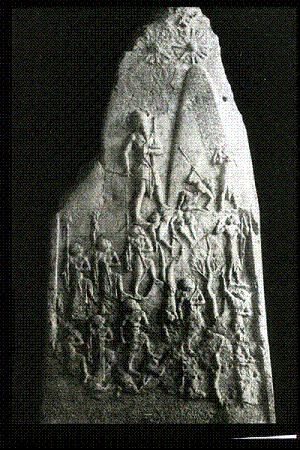 Naram-Suen's Victory Over the Lullubi, found in Susa
The Akkadian Empire reached it's peak during this time and Naram-Suen (2291-2255 BC) aggrandized his kingly titles accordingly, calling himself King of the Universe as well as the new title: King of the Four Regions. His name, both contemporary and subsequent to his reign, was prefixed with a star, denoting that he was a god. But despite his numerous military victories, he was unable to repel an invasion from the city of Guti, on the far north side of the Zagros mountains.
"Enlil, may the city that destroyed your city, be treated as your city has been treated! May the one that defiled your giguna, be treated as Nibru! In this city, may heads fill the wells! May no one find his acquaintances there, may brother not recognize brother! May its young woman be cruelly killed in her woman's domain, may its old man cry in distress for his slain wife! May its pigeons moan on their window ledges, may its small birds be smitten in their nooks, may it live in constant anxiety like a timid pigeon!"
The Sumerian text ends praising Inanna for the destruction of Agade.
157 are the years of the dynasty of Sharru-Kin. Then who was king? Who was not king? Irgigi was king, Imi was king, Nanûm was king, Ilulu was king, and the 4 of them ruled for only 3 years. 9 kings; they ruled for 161 years. Then Agade was defeated and kingship was taken to Uruk. |